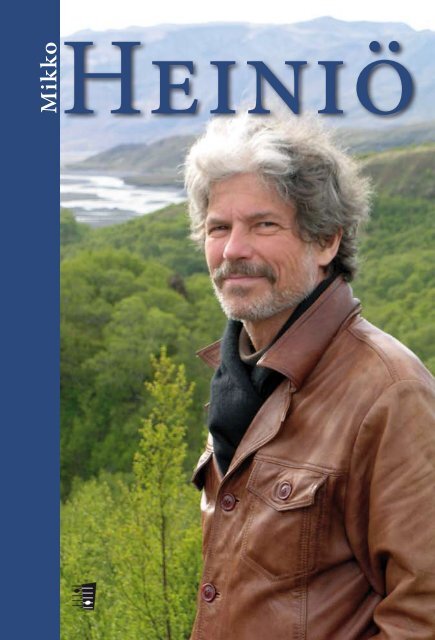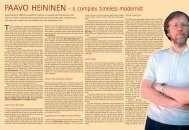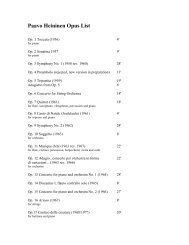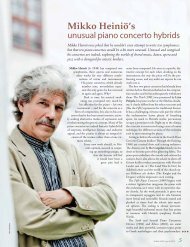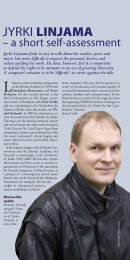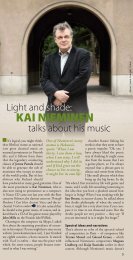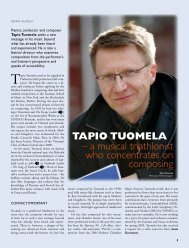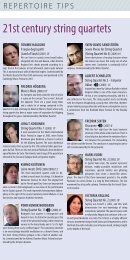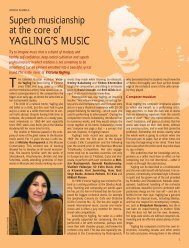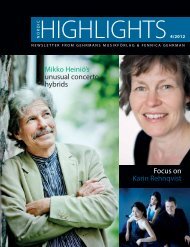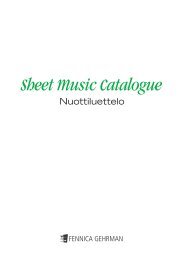Download a brochure of Heiniö (pdf) - Fennica Gehrman
Download a brochure of Heiniö (pdf) - Fennica Gehrman
Download a brochure of Heiniö (pdf) - Fennica Gehrman
Create successful ePaper yourself
Turn your PDF publications into a flip-book with our unique Google optimized e-Paper software.
Mikko<br />
<strong>Heiniö</strong>
MIKKO HEINIÖ’S MUSIC<br />
– vitality, positive energy and rhythmic drive<br />
An element <strong>of</strong> the unexpected, and a physical sense <strong>of</strong><br />
rhythm are fundamental features <strong>of</strong> the music <strong>of</strong> Mikko<br />
<strong>Heiniö</strong>, as are the playful and absurd, the gleeful feet-<strong>of</strong>f-theground<br />
feeling. In composing his music, he wishes to emulate<br />
the way in which Federico Fellini the film director and Antoni<br />
Gaudí the architect approached their art. “Their work<br />
has tremendous humanity, fantasy, humour and playfulness. I<br />
couldn’t work with a frown any more than they could.”<br />
Mikko <strong>Heiniö</strong> (b. 1948) has been a freelance composer since<br />
vacating the chair in musicology at the University <strong>of</strong> Turku<br />
a few years ago. As a researcher he is aware <strong>of</strong> the different<br />
types <strong>of</strong> music abroad in the world, and his widespread interest can<br />
be detected in his compositions on the topic <strong>of</strong> the human race and<br />
culture. He does not engage in playful irony with stylistic borrowings<br />
or dismiss them as ‘seen them all’. Instead, he cultivates an exultant<br />
but carefully-contrived brand <strong>of</strong> hybridism, vitality, positive energy<br />
and rhythmic drive. “I have a strong liking for characterised rhythm<br />
rooted in the spine and the pelvis. Rather than the mathematical abstraction<br />
<strong>of</strong> serial music, I must have a physical sense <strong>of</strong> rhythm.”<br />
<strong>Heiniö</strong> wrote his first opera, The Knight and the Dragon (Riddaren<br />
och draken, 1999–2000) for performance in a multi-dimensional,<br />
echoing church. Though by nature a static mystery play, it has an intensive<br />
pulse that generates a strong experience <strong>of</strong> spirituality. Then<br />
came The Hour <strong>of</strong> the Serpent (Käärmeen hetki, 2002–05), a character<br />
drama for a conventional opera stage. His third opera is about King<br />
Eric XIV <strong>of</strong> Sweden and Karin Månsdotter.<br />
His symphonies so far number two. Possible Worlds (1987) in postmodern<br />
style is marked by pluralism, reflection on tradition, borrowings<br />
and stylistic adaptations. The music is a combination <strong>of</strong> the unexpected<br />
and the inevitable, leading the listener ever onwards to a<br />
new experience. The result is a unique story that spirals back to its<br />
point <strong>of</strong> departure.<br />
Mikko <strong>Heiniö</strong> 1
2 Mikko <strong>Heiniö</strong><br />
The second symphony, Songs <strong>of</strong> Night and Love<br />
(Yön ja rakkauden lauluja, 1997) has a baritone soloist.<br />
<strong>Heiniö</strong> describes it as a symphony with a programme<br />
that is sung. The orchestra has plenty <strong>of</strong> independent<br />
things to say, and the baritone is only one<br />
voice among many. The work covers a broad span,<br />
from the nocturnal world <strong>of</strong> longing to the ecstaticrhythm<br />
procession music <strong>of</strong> the finale.<br />
Tendency towards rhythmic drive<br />
<strong>Heiniö</strong> was using ethnic influences to give his works<br />
extra life before there was ever any talk <strong>of</strong> world music.<br />
“I don’t know how it originally came about. At<br />
school, I played rhythm music in a rock band. My<br />
teacher during my year in Berlin in 1975 was Witold<br />
Szalonek, who was interested in ethnic cultures. I<br />
chose my records and concerts on two grounds: ethnic<br />
and contemporary.”<br />
The rhythm emanating from the pelvis really goes<br />
to town in On the Rocks (1998) for orchestra.<br />
The orchestral song cycle Vuelo de alambre (1983)<br />
is based on poems by anonymous Chilean prisoners. Despite their<br />
grim background, the texts also express memories and longing. The<br />
hidden melodies <strong>of</strong> the Andies, the marching songs and Latin-American<br />
rhythms sometimes find themselves on a collision course, but the<br />
emergent eloquence finally radiates sympathy, tenderness and optimism.<br />
“I have a tendency towards rhythms <strong>of</strong> African origin, even if they<br />
have travelled via South America and the Caribbean. But I avoid<br />
stuck-on effects, because they lead to postcard folklorism. I examine<br />
the deep structures from a European, analytical perspective to see<br />
what I can build on them. Pentatonicism, for example, has somehow<br />
to be chromaticised, and the overall sound ends up as European.”<br />
Vuelo de alambre uses a 12-note row from which two pentatonic<br />
scales gradually become distinguishable as the work proceeds. Expressive<br />
chromaticism and folk music overlap, join and part.<br />
<strong>Heiniö</strong> liberally bends types <strong>of</strong> music with a strong rhythm to suit<br />
his purpose: tango, boogie, rhythm & blues and jazz. The time he<br />
spent in Benin in West Africa is reflected in the part for five percussionists<br />
in his piano concerto Khora.
Hybrids and singability<br />
In composing his music, <strong>Heiniö</strong> wishes to emulate the way in which<br />
Federico Fellini the film director and Antoni Gaudí the architect approached<br />
their art. “Their work has tremendous humanity, fantasy,<br />
humour and playfulness. I couldn’t work with a frown any more than<br />
they could.”<br />
Hybrids – unexpected and <strong>of</strong>ten crossover formats – are a fundamental<br />
feature <strong>of</strong> <strong>Heiniö</strong> the composer. The sixth piano concerto,<br />
Hermes (1994), and the seventh, Khora (2001), are both dance works<br />
although they can also be performed as concert versions. In the sixth<br />
the solo piano is <strong>of</strong>fset by a string orchestra and soprano, in the seventh<br />
by five percussionists. Envelope (2002) for solo trumpet and orchestra<br />
was composed round the Haydn Trumpet Concerto, and to<br />
be performed without a break between the movements. The Haydn<br />
orchestra plays up on the platform, but the other instruments ‘envelop’<br />
the audience. The soloist moves from place to place.<br />
As a young man, <strong>Heiniö</strong> dreamt <strong>of</strong> a career as a writer and philologist<br />
but in the end chose music. In many <strong>of</strong> his songs and choral<br />
works he has subjected the linguistic parameters <strong>of</strong> his texts to almost<br />
systematic treatment. At one extreme are the works whose texts are<br />
broken down into their basic phonetic units devoid <strong>of</strong> any semantic<br />
content. Representing the other extreme are the vocal works in which<br />
the meaning is all-important.<br />
In Non-Stop (1995) for mixed choir the nonsense words<br />
provide flexible substance for timbres and rhythms lent impact<br />
by consonants. The rolling beat unfolds over a pliable<br />
harmonic background.<br />
The dialect <strong>of</strong> Western Finland also supplies<br />
colour and laid-back rhythms in the setting<br />
<strong>of</strong> poems by Heli Laaksonen in the<br />
five-movement Pikavuaro Turkku<br />
(Turku Express, 2001) for mixed<br />
choir. <strong>Heiniö</strong> gives<br />
the poems an<br />
airily tonal,<br />
folk song-like<br />
ambience overlaid<br />
with discreet<br />
layers <strong>of</strong> polyphonic rhythm.<br />
Wind Pictures (1991) for choir<br />
Mikko <strong>Heiniö</strong> 3
4 Mikko <strong>Heiniö</strong><br />
and orchestra is in one sense a Requiem for Hei niö’s daughter, who<br />
died when still very young, but it also expands into a broad wind metaphor<br />
the harmony <strong>of</strong> which is fecundated by a 10-note chord discovered<br />
in some sketches by Skryabin. Also in the fourth movement,<br />
Tuuli Maria, is a <strong>Heiniö</strong> lullaby he sang to his daughter.<br />
<strong>Heiniö</strong> has admirably solved the problem <strong>of</strong> singability in modern<br />
music. In the Sextet (2000, for baritone and Schönbergian “Pierrot ensemble”)<br />
there are no awkward interval jumps. Diatonic cells can be<br />
detected, and there are no bulky chromatic blocks in the melodic flow.<br />
Embraced in the light, bright sound <strong>of</strong> the seven-movement work is an<br />
awareness <strong>of</strong> disappointment wounded by love, detached and numb.<br />
The falsetto singing in the skittish scherzo creates some ironic, comic<br />
dimensions.<br />
Playfulness and drama in chamber music<br />
The musicians performing <strong>Heiniö</strong>’s works are also <strong>of</strong>fered a touch <strong>of</strong><br />
physical drama, as in the Piano Quintet (1993), where they are expected<br />
to speak and hum text by Lewis Carroll. The resonances <strong>of</strong><br />
the human body serve as a physical timbral extension that also has the<br />
ingredients for a hybrid. The playful and absurd, the gleeful feet-<strong>of</strong>fthe-ground<br />
feeling are features <strong>of</strong> this composer.<br />
Wood is present in the piano quartet The Voice <strong>of</strong> the Tree (Puun<br />
ääni, 2006) inspired by the poetry <strong>of</strong> Eira Stenberg, in a very concrete<br />
manner; its feel is part <strong>of</strong> the physical aspect <strong>of</strong> the music. In addition<br />
to being played in the normal way, the strings are dampened,<br />
plucked, struck, tapped and rubbed to bring out the intrinsic sound <strong>of</strong><br />
the wood, the soulfulness <strong>of</strong> which is far from mere dry woodworking.<br />
The string trio and piano together constitute a vision in which the<br />
listener may similarly detect the tree swaying in the wind, the movements<br />
<strong>of</strong> the branches and details <strong>of</strong> the foliage.<br />
Mikko <strong>Heiniö</strong> has long been a focal figure on the Finnish musical<br />
scene and continues to be so as Chairman <strong>of</strong> the Society <strong>of</strong> Finnish<br />
Composers and Vice-Chairman <strong>of</strong> Teosto, the Finnish Composers’<br />
Copyright Society. He has been composer-in-residence <strong>of</strong> the Turku<br />
Philharmonic Orchestra for more than a decade, and he was the author<br />
<strong>of</strong> the volume on contemporary music in the History <strong>of</strong> Finnish<br />
Music that won the nation’s most prestigious prize for non-fiction, the<br />
Tieto-Finlandia.<br />
Jukka Isopuro<br />
Translation: Susan Sinisalo
CURRICULUM VITAE<br />
Mikko <strong>Heiniö</strong> (born on 18 May 1948) studied piano with<br />
Liisa Pohjola and composition with Joonas Kokkonen at<br />
the Sibelius Academy from 1971 to 1975. The two years<br />
1975–77 were spent with the Polish teacher Witold Szalonek in Berlin.<br />
<strong>Heiniö</strong> also studied musicology at the University <strong>of</strong> Helsinki, finishing<br />
his doctoral thesis in 1984 and working as Pr<strong>of</strong>essor <strong>of</strong> Musicology<br />
at the University <strong>of</strong> Turku from 1985 to 2005.<br />
<strong>Heiniö</strong>´s repertoire contains over 80 works. The main pieces <strong>of</strong> his<br />
music are his orchestral works such as eight piano concertos, Vuelo de<br />
Alambre (cycle for voice and orchestra, 1983), two symphonies (Possible<br />
Worlds, 1987 and Songs <strong>of</strong> Night and Love, 1997), Wind Pictures<br />
for choir and orchestra (1991), On the Rocks (1998), trumpet<br />
concerto Envelope (2002) and Alla Madre for violin<br />
and orchestra (2006). Among his main chamber<br />
music works are Framtidens Skugga for soprano<br />
and brass band (1980), Piano Trio (1988), Piano<br />
Quintet (1993), Treno Della Notte (2000) and<br />
Café au Lait (2006). Of his choral works, one<br />
could mention Three Folk Songs (1977), Luceat<br />
(1992), Non-Stop (1995) and Pikavuaro<br />
Turkku (Turku Express, 2002).<br />
Especially in his piano concertos <strong>Heiniö</strong> has<br />
combined different musical genres and types<br />
<strong>of</strong> expression: his fourth piano concerto Genom<br />
Kvällen (Through the Evening, 1986) features a<br />
choir and a string orchestra with the soloist; in the<br />
sixth (Hermes, 1994) there is a soprano and a string orchestra<br />
as well, and his eight, Månkonsert (The Moon Concerto, 2008) introduces<br />
a mezzo-soprano and a large orchestra. Hermes and his seventh<br />
piano concerto Khora were planned together with choreographer Tiina<br />
Lindfors for the dance theatre ERI. Lindfors has also three other<br />
choreographies on her account made for <strong>Heiniö</strong>´s music.<br />
In recent years, <strong>Heiniö</strong> has been gearing towards musical theatre.<br />
He composed a church opera, The Knight and the Dragon (Riddaren<br />
och Draken, 2000) for Turku Cathedral´s 700th anniversary<br />
and Käärmeen hetki (The Hour <strong>of</strong> the Serpent, 2002–2005), an opera<br />
premiered by the Finnish National Opera. His third opera about the<br />
Mikko <strong>Heiniö</strong> 5
6 Mikko <strong>Heiniö</strong><br />
King Eric XIV <strong>of</strong> Sweden and his<br />
wife Karin Månsdotter was commissioned<br />
for Turku’s year as European<br />
Capital <strong>of</strong> Culture in 2011.<br />
In addition to composing, Mikko<br />
<strong>Heiniö</strong> is one <strong>of</strong> Finland’s leading<br />
musicologists. His doctoral<br />
dissertation entitled “The idea <strong>of</strong><br />
innovation and tradition” (1984)<br />
dealt with the musical philosophy<br />
<strong>of</strong> contemporary Finnish composers.<br />
Articles by him on 20th century<br />
Finnish music, neoclassicism,<br />
dodecaphony, serialism and postmodernism are to be found in The<br />
History <strong>of</strong> Finnish Music (Volume 4, Contemporary Music). <strong>Heiniö</strong><br />
has also had a number <strong>of</strong> articles published in the Finnish Music<br />
Quarterly. The total amount <strong>of</strong> his musicological articles reaches over<br />
two hundred overall. He has been granted a number <strong>of</strong> awards such<br />
as Tieto-Finlandia (1997) together with Erkki Salmenhaara and Fabian<br />
Dahlström, and Suomi-palkinto (the Finland Award, 2006) by<br />
the Cultural Ministry <strong>of</strong> Finland.<br />
<strong>Heiniö</strong> is a member <strong>of</strong> the Board <strong>of</strong> Teosto (the Finnish Composers’<br />
Copyright Bureau) and Luses (the Foundation for the Promotion<br />
<strong>of</strong> Finnish Music). He has been the Chairman <strong>of</strong> the Society <strong>of</strong> Finnish<br />
Composers since 1992. He has also been elected as a member <strong>of</strong><br />
the Royal Swedish Academy <strong>of</strong> Music in May 2004.
LIST OF WORKS<br />
STage WoRKS<br />
Hermes (Piano Concerto No. 6) (1994)<br />
Dance Pictures for Piano, Soprano and Strings<br />
See: Works for Soloist(s) and Orchestra<br />
Khora (Piano Concerto No. 7) (2001)<br />
Dance Images for Piano and<br />
Five Percussionists<br />
See: Works for Soloist(s) and Orchestra<br />
The Hour <strong>of</strong> the Serpent /<br />
Käärmeen hetki (2002–2005)<br />
Opera in Two Acts<br />
Libretto by Juha Siltanen (in Finnish)<br />
3 sopranos, 1 mezzo-soprano, 1 alto,<br />
1 tenor, 1 baritone, 1 bass-baritone, 1 bass,<br />
mixed choir, orchestra: 3333/4331/13/1,<br />
piano, strings<br />
Duration: ca. 2 h 30 min<br />
Commissioned by the Finnish National<br />
Opera<br />
Fp: cond. Hannu Lintu, dir. Erik Söderblom,<br />
Finnish National Opera,<br />
September 15, 2006<br />
Ground-breaking modern opera<br />
…An example <strong>of</strong> the most ambitious and<br />
most ground-breaking modern opera<br />
drama ever staged in Finland.<br />
Turun Sanomat 2006<br />
The Knight and the Dragon / Riddaren och draken (1999–2000)<br />
Church Opera<br />
Libretto by Bo Carpelan (in Swedish)<br />
2 sopranos, 1 mezzo-soprano, 1 alto, 1 tenor, 1 bass-baritone, 1 bass, 2 female<br />
choirs, 2 male choirs, orchestra: 2222/4331/13/0, organ, strings<br />
Intrada – Act I – Intermezzo – Act II – Coda<br />
Duration: ca. 1 h 15 min<br />
Commissioned by the City <strong>of</strong> Turku and its congregations, Turku University and<br />
Opera Society for the 700th anniversary <strong>of</strong> Turku Cathedral<br />
Fp: Turku City Orchestra, cond. Ulf Söderblom,<br />
Turku Cathedral, November 9, 2000<br />
Appeal to the eye, the ear and the mind<br />
One <strong>of</strong> the most impressive operas written over<br />
the past few years … The music depicting light,<br />
in particular, generates a sense <strong>of</strong> dazzling beauty …<br />
A successful appeal to the eye,<br />
the ear and the mind.<br />
Helsingin Sanomat 2000<br />
Mikko <strong>Heiniö</strong> 7
8 Mikko <strong>Heiniö</strong><br />
Päivi Nisula in <strong>Heiniö</strong>’s opera The Hour <strong>of</strong> the Serpent
WoRKS foR oRCHeSTRa<br />
Concerto grosso (1975)<br />
string orchestra and harpsichord<br />
Duration: 21’<br />
Commissioned by the Oslo<br />
Kammerorkester<br />
Fp: Oslo Kammerorkester, cond. Ornulf<br />
Boye Hansen, Oslo, April 22, 1977<br />
manuscript<br />
Tredicia (1976)<br />
3333/4331/13/0, strings<br />
Duration: 13’<br />
Fp: Finnish Radio Symphony Orchestra,<br />
cond. Leif Segerstam, Helsinki,<br />
December 13, 1978<br />
manuscript<br />
Concerto for Orchestra (1982)<br />
3333/4331/13/1, piano, strings<br />
Duration: 28’<br />
Commissioned by the Turku<br />
Philharmonic Orchestra<br />
Fp: Turku PO, cond. Pertti Pekkanen,<br />
Turku, November 11, 1982<br />
manuscript<br />
Drone (1982)<br />
(third movement <strong>of</strong> Concerto for<br />
Orchestra)<br />
Duration: 6’<br />
manuscript<br />
Possible Worlds (1987)<br />
A Symphony<br />
3333/4331/13/1, piano, strings<br />
Duration: 34’<br />
Commissioned by the Turku<br />
Philharmonic Orchestra<br />
Fp: Turku PO, cond. Igor Bezrodnyi,<br />
Turku, December 10, 1987<br />
Fp (with choreography): Dance Theatre<br />
ERI, Tiina Lindfors, choreography, Turku<br />
PO, cond. Hannu Lintu, Turku,<br />
September 16, 1999<br />
Dall’ ombra all’ombra (1992)<br />
Seven Variations, Theme and Coda for<br />
Orchestra and Synthesizer<br />
2222/4330/13/0, synthesizer, strings<br />
Duration: 13’<br />
Commissioned by the Turku<br />
Conservatory<br />
Fp: Turku Conservatory<br />
Symphony Orchestra, cond. Janne<br />
Haapanen, Turku, November 28, 1992<br />
Trias (1995)<br />
de “O quam mundum” (Piae Cantiones<br />
1582: LXXI)<br />
2222/4631/13/0, strings<br />
Duration: 10’<br />
Commissioned by the University <strong>of</strong><br />
Turku for its 75th anniversary<br />
Fp: Turku Philharmonic Orchestra, cond.<br />
Janne Haapanen, Turku, May 26, 1995<br />
Minne (1996)<br />
string orchestra<br />
Duration: 18’<br />
Commissioned by the Korsholm Festival<br />
Fp: Ostrobothnian Chamber Orchestra,<br />
cond. Juha Kangas, Korsholm Music<br />
Festival, June 27, 1997<br />
Symphony No. 2 ”Songs <strong>of</strong> Night<br />
and Love” (“Yön ja rakkauden<br />
lauluja”) (1997)<br />
See: Works for Soloist(s) and Orchestra<br />
On the Rocks (1998)<br />
3333/4331/13, piano (doubling celesta),<br />
strings<br />
Duration: 13’<br />
Commissioned by the Finnish<br />
Broadcasting Company<br />
Fp: Finnish Radio Symphony Orchestra,<br />
cond. Sakari Oramo, Helsinki,<br />
November 13, 1998<br />
Enjoyable opening number<br />
I didn’t expect On the Rocks to be so<br />
fine, quite a masterpiece in fact. …<br />
I enjoyed it purely as music,<br />
eagerly drinking in its gentle<br />
harmonies, its graceful melodies<br />
and magnificent timbres.<br />
Etelä-Suomen Sanomat 2004<br />
Sonata da chiesa (2005)<br />
Four Serpent Scenes in the Old<br />
Testament<br />
brass, celesta and percussion (4 French<br />
horns, 3 trumpets, 3 trombones, tuba,<br />
celesta, timpani, 3 percussionists)<br />
1. The Serpent in Eden<br />
(Käärme Paratiisissa)<br />
2. Moses Turns the Staff into a Snake<br />
(Mooses muuttaa sauvan<br />
käärmeeksi)<br />
3. The Bronze Snake (Pronssikäärme)<br />
4. Leviathan (Leviatan)<br />
Duration: ca. 16’<br />
Commissioned by the Turku and<br />
Kaarina Parish Union<br />
Fp: Turku Philharmonic Orchestra,<br />
cond. Markus Lehtinen, Katedraali soi!<br />
festival, Turku, February 9, 2006<br />
Sensual timbres and swing!<br />
<strong>Heiniö</strong> has an ear for sensual timbres,<br />
but equally marked in this new work is<br />
his liking for rhythmic romping. For the<br />
second movement <strong>of</strong> the Church Sonata<br />
is a real boogie with a swing that sets one<br />
wondering what sort <strong>of</strong> music <strong>Heiniö</strong><br />
would write for big band.<br />
Turun Sanomat 2006<br />
Maestoso, Variations on a Theme by<br />
erik XIV (2008)<br />
3333/4331/13/1, strings<br />
Duration: 8’<br />
Mikko <strong>Heiniö</strong> 9
WoRKS foR SoLoIST(S) aND oRCHeSTRa<br />
Khora (Piano Concerto No. 7) (2001)<br />
Dance Images for Piano and Five Percussionists<br />
solo piano+percussion group (5 players)<br />
Introduction (Johdanto) [in the scene version only]<br />
1. Khora I<br />
2. The Mirror (Peili)<br />
3. Oidipus<br />
4. Eros & Thanatos<br />
5. Khora II<br />
Duration: 45’ (concert version 35’)<br />
Commissioned by the Dance Theatre ERI with support <strong>of</strong> the<br />
Madetoja Foundation<br />
Fp: Juhani Laukola, piano, Kroustikon Percussion Ensemble,<br />
cond. Risto Pulkkinen, Dance Theatre ERI with choreography<br />
by Tiina Lindfors, Turku, November 8, 2001<br />
10 Mikko <strong>Heiniö</strong><br />
Happy combination <strong>of</strong> rhythm and sound<br />
…A magnificent, innovative and sonorous piece for small<br />
ensemble. …The fact that <strong>Heiniö</strong> scored it almost exclusively<br />
for percussion well supports the message and gives it a touch<br />
<strong>of</strong> originality.<br />
Åbo underrättelser 2001<br />
A thundering text that beautifully balances the choreography.<br />
The timpani and other percussion nuances combined with the<br />
clear voice <strong>of</strong> the piano are sublime.<br />
Hufvudstadsbladet 2001<br />
Tiina Lindfors and Alexander Zilbermann as Eros<br />
and Thanatos in <strong>Heiniö</strong>’s Khora
Khora<br />
Mikko <strong>Heiniö</strong> 11
Khora (Piano Concerto No. 7)<br />
12 Mikko <strong>Heiniö</strong>
Khora<br />
Mikko <strong>Heiniö</strong> 13
Neljä yölaulua / four Night Songs<br />
(1972)<br />
baritone or contralto and orchestra:<br />
2222/4230/11/0, celesta, piano, strings<br />
(also available as a version for voice and<br />
piano)<br />
Text: Mikko <strong>Heiniö</strong> (in Finnish)<br />
Duration: 10’<br />
Fp: Olavi Hautsalo, baritone, Pentti<br />
Koskimies, piano, Helsinki, May 10, 1973<br />
manuscript<br />
Concerto for french Horn and<br />
orchestra (1978)<br />
solo horn+2222/0230/12/0, piano,<br />
strings<br />
Duration: 26’<br />
Fp: Esa-Pekka Salonen, horn, Pori City<br />
Orchestra, cond. Atso Almila, Pori,<br />
March 5, 1980<br />
manuscript<br />
Concerto for Piano and orchestra<br />
No. 3 (1981)<br />
solo piano+2222/4330/13/0, celesta,<br />
strings<br />
Duration: 28’<br />
Fp: Liisa Pohjola, piano, Tampere<br />
Philharmonic Orchestra, cond. Atso<br />
Almila, Tampere, February 23, 1984<br />
genom kvällen (Concerto for Piano<br />
and orchestra No. 4) (1986)<br />
See: Choral Works<br />
Concerto for Piano and orchestra<br />
No. 5 (1989)<br />
solo piano+2222/4330/12/0, strings<br />
Duration: 25’<br />
Commissioned by the Association <strong>of</strong><br />
Finnish Symphony Orchestras<br />
Fp: Ralf Gothóni, piano, Turku<br />
Philharmonic Orchestra, cond. Pertti<br />
Pekkanen, Turku, April 5, 1990<br />
Hermes (Piano Concerto No. 6)<br />
(1994)<br />
Dance Pictures for Piano, Soprano and<br />
Strings<br />
Duration: 52’–55’<br />
Commissioned by the Dance Theatre ERI<br />
and Turku Music Festival<br />
Fp: Juhani Lagerspetz, piano, Camilla<br />
Nylund, soprano, Ostrobothnian<br />
Chamber Orchestra, cond. Juha Kangas,<br />
Dance Theatre ERI with choreography<br />
by Tiina Lindfors, Turku Music Festival,<br />
August 11, 1995<br />
14 Mikko <strong>Heiniö</strong><br />
Vuelo de alambre<br />
(Barbed-wire flight) (1983)<br />
soprano and orchestra: 3333/4331/13/1,<br />
celesta and piano (1 player), strings<br />
Texts: anonymous Chilean prisoners<br />
(in Spanish)<br />
1. Prelude<br />
2. Tengo (I Have)<br />
3. Electra<br />
4. Fué anoche (It Happened Last Night)<br />
5. Tres Alamos<br />
6. Postlude<br />
Duration: 28’<br />
Commissioned by the Finnish<br />
Broadcasting Company<br />
Fp: Eija Orpana-Martin, soprano, Finnish<br />
Radio Symphony Orchestra, cond.<br />
Jorma Panula, Helsinki, April 3, 1985<br />
Fué anoche<br />
Fué anoche<br />
allá en el sur,<br />
entre la última primavera<br />
acumulada,<br />
que llegaron tus manos<br />
como un suave golpe de aqua.<br />
No hablaste,<br />
estabas ahí.<br />
El sol, mientras tanto,<br />
proponía a los árboles<br />
su estatura de sombras.<br />
Y en el silenzio de la luz<br />
y de los patios,<br />
trotaban mis hijos<br />
con pasitos de esquina y mariposa.<br />
Y entre tu sombra<br />
y la mía<br />
volantines transitorios<br />
levantaron hacia el norte<br />
su vuelo de alambre.<br />
En la tarde,<br />
organizada en la distancia<br />
la intranquilidad de los espacios,<br />
mi retorno,<br />
como la lluvia,<br />
como tus manos.<br />
It is high time…<br />
My pal Guy Rickards astutely<br />
described Vuelo de Alambre and<br />
Possible Worlds as ‘like serial Villa-<br />
Lobos’; Hermes is pulsing with<br />
energetic life; and now an opera,<br />
The Knight and the Dragon, which<br />
is a phenomenal achievement. It’s<br />
high time we started paying a lot<br />
more attention to <strong>Heiniö</strong>.<br />
Toccata Press 2001 (Martin<br />
Anderson)<br />
It Happened Last Night<br />
It happened last night,<br />
down there in the south,<br />
when spring was<br />
at its height,<br />
our hands came,<br />
like a gentle shower <strong>of</strong> water.<br />
You did not speak,<br />
You just were there.<br />
The sun, meanwhile,<br />
<strong>of</strong>fered the trees its shade,<br />
the whole way down.<br />
And in the silence <strong>of</strong> the light<br />
and the courtyards,<br />
ran my children<br />
with steps as light as a butterfly.<br />
And between your shadow<br />
and mine<br />
the passing kites<br />
rose towards the north<br />
on their barbed-wire flight.<br />
In the afternoon,<br />
at an organized distance<br />
the restlessness <strong>of</strong> space,<br />
my return,<br />
like rain,<br />
like our hands.<br />
Chacabuco, February 7, 1974
Symphony No. 2<br />
”Songs <strong>of</strong> Night and Love”<br />
(“Yön ja rakkauden lauluja”) (1997)<br />
baritone and orchestra: 3333/4331/13/1,<br />
celesta and piano (1 player), strings<br />
Text: Lassi Nummi (in Finnish)<br />
1. Haluan sinua, haluan sinut<br />
(I Want You, All <strong>of</strong> You)<br />
2. Meren hiljaisuus (Silence <strong>of</strong> the Sea)<br />
3. Sydänyöllä (At Dead <strong>of</strong> Night)<br />
4. Juhla, unen aalto<br />
(Celebration, a Wave <strong>of</strong> Sleep)<br />
Duration: 37’<br />
Commissioned by the Turku<br />
Philharmonic Orchestra<br />
Fp: Tommi Hakala, baritone,<br />
Turku PO, cond. Ilpo Mansnerus, Turku,<br />
May 14, 1998<br />
Sensual music – <strong>Heiniö</strong>’s “Tristan”<br />
The second symphony is Mikko <strong>Heiniö</strong>’s<br />
“Tristan”, so much Wagnerian semidarkness<br />
and mood does it contain. …<br />
<strong>Heiniö</strong> has written sensual music, a long<br />
orchestral ballad…<br />
Hufvudstadsbladet 2001<br />
envelope (2002)<br />
for Haydn’s Trumpet Concerto in Eb<br />
solo trumpet+3333/4331/13/1, piano,<br />
strings<br />
Duration: pre Haydn 12’30”, post Haydn<br />
7’30”<br />
(the work is played without breaks<br />
before and after the Haydn Concerto;<br />
it includes also a cadenza and two<br />
sections linking the separate concerto<br />
movements together)<br />
Commissioned by the Turku<br />
Philharmonic Orchestra<br />
Fp: Ole Edvard Antonsen, trumpet,<br />
Turku PO, cond. Rudolf Werthen, Turku,<br />
September 19, 2002<br />
Rhythmic riot from <strong>Heiniö</strong><br />
The wildest torrent <strong>of</strong> sound was<br />
unleashed in Mikko <strong>Heiniö</strong>’s Envelope.<br />
In this riot <strong>of</strong> postmodern timbres,<br />
tumult and rhythm the composer has<br />
“enveloped” the Trumpet Concerto by<br />
Joseph Haydn.<br />
Helsingin Sanomat 2008<br />
alla madre (2007)<br />
solo violin+3333/4331/13, harp, strings<br />
1. Arrivo (Allegretto pesante – Agitato)<br />
2. Aura (Andante – Allegro)<br />
3. Carezza (Cadenza – Cantabile)<br />
Duration: 30’<br />
Commissioned by the Turku<br />
Philharmonic Orchestra<br />
Fp: Kurt Nikkanen, violin, Turku PO,<br />
cond. Petri Sakari, Turku, May 15, 2008<br />
A fantasy journey<br />
…An instrumental adventure and<br />
a fantasy journey. It is obviously<br />
challenging and fun to do for soloist and<br />
orchestra alike and keeps the audience’s<br />
interest awake every moment.<br />
Helsingin Sanomat 2008<br />
Moon Concerto / Månkonsert<br />
(Piano Concerto No. 8) (2007–08)<br />
Reflections and Variations on Themes by<br />
John Dowland and Hugo Ingelius<br />
mezzo-soprano, piano and orchestra:<br />
3333/4331/13/1, celesta, strings<br />
Text: Edith Södergran, Carl Snoilsky<br />
(in Swedish)<br />
1. Nocturne<br />
2. Rosso<br />
3. Finale<br />
Duration: 38’<br />
Commissioned by the Finnish Radio<br />
Symphony Orchestra<br />
Fp: Heini Kärkkäinen, piano, Monica<br />
Groop, mezzo-soprano, Finnish RSO,<br />
Helsinki, September 23, 2009<br />
Syyskesän laulu / Late Summer<br />
Song (2008)<br />
bass and chamber orchestra:<br />
2222/2200/1, strings<br />
(also available a version for bass and<br />
piano)<br />
Text: Lassi Nummi (in Finnish)<br />
Duration: 17’<br />
1. Suuri valo (The Great Light)<br />
2. Kun saavumme tähän hetkeen<br />
(When We Reach this Moment)<br />
3. Tämä outo seutu (This Strange<br />
Region)<br />
4. Virran partaalla (By the Stream)<br />
5. Välimeri (The Mediterranean)<br />
6. Taivaalla kuu (The Moon in the Sky)<br />
7. Syyskesä (Late Summer)<br />
Commissioned by the Turku and Kaarina<br />
Parish Union<br />
Mikko <strong>Heiniö</strong> 15
Symphony No. 2 “Songs <strong>of</strong> Night and Love”<br />
16 Mikko <strong>Heiniö</strong>
Symphony No. 2<br />
Mikko <strong>Heiniö</strong> 17
CHaMBeR WoRKS<br />
Suite for flute and Two guitars<br />
(1974)<br />
Duration: 15’<br />
Fp: Ilari Lehtinen, flute, Rolf Holmberg<br />
and Pekka Vesanen, guitars, Helsinki,<br />
May 10, 1974<br />
manuscript<br />
Trio for oboe, Bassoon and<br />
Harpsichord (1976)<br />
Duration: 15’<br />
Fp: Aale Lindgren, oboe, Matti<br />
Tossavainen, bassoon, Kari Jussila,<br />
harpsichord, Helsinki, July 29, 1976<br />
akasa (1977)<br />
6 trombones<br />
Duration: 11’<br />
Fp: Trombone course <strong>of</strong> the Jyväskylä<br />
Arts Festival, cond. Mikko <strong>Heiniö</strong>,<br />
Jyväskylä, July 7, 1977<br />
Publisher: Jasemusiikki<br />
four finnish folktunes /<br />
Neljä kansansävelmää (1977)<br />
(arr.)<br />
4 trombones<br />
Duration: 6’30’’<br />
Notturno di fiordo (1978)<br />
flute/piccolo and harp<br />
Duration: 17’<br />
Commissioned by NOMUS<br />
Fbp: Ilari Lehtinen, flute, Marjatta Haahti,<br />
harp, Finnish Broadcasting Company,<br />
1979<br />
Publisher: Society <strong>of</strong> Finnish Composers<br />
Brass Mass (1979)<br />
4 trumpets, 4 trombones and tuba (ad lib.)<br />
Duration: 16’<br />
Fp: Finnish Brass Ensemble, cond. Mikko<br />
<strong>Heiniö</strong>, Helsinki, April 15, 1980<br />
Duo for Violin and Piano / Duo per<br />
violino e pian<strong>of</strong>orte (1979)<br />
Duration: 16’30’’<br />
Commissioned by the Finnish<br />
Broadcasting Company<br />
Fbp: Erkki Palola, violin, Risto Kyrö,<br />
piano, Finnish Broadcasting Company,<br />
May 5, 1980<br />
Champignons à l´herméneutique<br />
(1979)<br />
Divertimento for Flute and Guitar<br />
Duration: 16’30’’<br />
Fp: Liisa Ruoho, flute, Pekka Vesanen,<br />
guitar, Helsinki, December 16, 1980<br />
Publisher: Jasemusiikki<br />
18 Mikko <strong>Heiniö</strong><br />
Minimba 1 (1982)<br />
Canon for 4 (or 3) Guitars<br />
Duration: 7’30’’<br />
Fp: Pekka Vesanen, Kari Äikäs, Juan<br />
Antonio Muro, Ilmari Hytönen, guitars,<br />
Espoo, May 3, 1984<br />
Publisher: Jasemusiikki<br />
“...in spe” (1984)<br />
Diaphony for Saxophone and Marimba/<br />
Vibraphone<br />
Duration: 7’30’’<br />
Fbp: Pekka Savijoki, saxophone, Tim<br />
Ferchen, marimba/vibraphone, Finnish<br />
Broadcasting Company, 1985<br />
Publisher: Jasemusiikki<br />
Piano Trio (1988)<br />
Duration: 13’<br />
Commissioned by the Kuhmo Chamber<br />
Music Festival<br />
Fp: Fontenay Trio (Wolf Harden, piano,<br />
Michael Mucke, violin, Niklas Schmidt,<br />
cello), Kuhmo Chamber Music Festival,<br />
July 19, 1989<br />
In g (1988)<br />
cello and piano<br />
Duration: 7’<br />
Commissioned by the Musical Society<br />
<strong>of</strong> Turku for the Turku Cello Competition<br />
1990<br />
Fp: Participants in the Turku Cello<br />
Competition (2nd round), January<br />
16–17, 1990<br />
aurora (1989)<br />
Fanfare for Brass<br />
4 horns, 3 trumpets, 3 trombones, tuba<br />
Duration: 1’<br />
Fp: Turku Philharmonic Orchestra, cond.<br />
Jacques Mercier, Turku, May 9, 1990<br />
2nd prize in the competition <strong>of</strong> the<br />
350th Anniversary <strong>of</strong> the University <strong>of</strong><br />
Helsinki<br />
manuscript<br />
Wintertime (1990)<br />
Seven Fragments for Vibraphone/<br />
Marimba and Harp<br />
Duration: 9’<br />
Fp: Risto Pulkkinen, vibraphone/<br />
marimba, Mikko Leistola, harp,<br />
Stockholm, November 8, 1991<br />
Publisher: Jasemusiikki<br />
Piano Quintet (1993)<br />
2 violins, viola, cello, piano<br />
Text: Lewis Carroll (in English)<br />
Duration: 15’<br />
Commissioned by the Kuhmo Chamber<br />
Music Festival<br />
Fp: New Helsinki Quartet (Jan<br />
Söderblom, I violin, Petri Aarnio, II violin,<br />
Ilari Angervo, viola, Jan-Erik Gustafsson,<br />
cello), Heini Kärkkäinen, piano, Kuhmo<br />
Chamber Music Festival, July 20, 1994<br />
ReLay (1998)<br />
violin and cello<br />
Duration: 13’<br />
Commissioned by the Turku Music<br />
Festival<br />
Fp: Per Enoksson, violin, Martti Rousi,<br />
cello, Turku, August 7, 1998<br />
7.2.1949 (1998)<br />
50 Measures and Coda for Seppo<br />
Kimanen for his 50th Anniversary Day<br />
clarinet, cello and piano<br />
Duration: 1’40’’<br />
Fp: Kari Kriikku, clarinet, Jan-Erik<br />
Gustafsson, cello, Juhani Lagerspetz,<br />
piano, Helsinki, February 7, 1999<br />
manuscript<br />
espresso (1999)<br />
violin, cello and piano<br />
Duration: 3’<br />
Commissioned by the Juvenalia<br />
Chamber Music Competition<br />
Fp: Juvenalia Chamber Music<br />
Competition, February 2001<br />
Publisher: Modus Music<br />
Treno della notte (2000)<br />
clarinet, cello and piano<br />
Duration: 18’<br />
Commissioned by the Kuhmo Chamber<br />
Music Festival<br />
Fp: Tuulia Ylönen, clarinet, Marko Ylönen,<br />
cello, Heini Kärkkäinen, piano, Kuhmo<br />
Chamber Music Festival, July 29, 2001<br />
Tremendous drive<br />
Treno della notte is a simply splendid<br />
work. It has tremendous drive from<br />
beginning to end. …The syncopated beat<br />
with traces <strong>of</strong> jazz and Klezmer sets feet<br />
tapping.<br />
Helsingin Sanomat 2001<br />
Café au lait (2006)<br />
flute, clarinet, violin, cello and piano<br />
1. Le matin – Timporata<br />
2. Mami Wata<br />
3. Tipinti et Abalacodje – La nuit<br />
Duration: 16’<br />
Commissioned by the Turku Music<br />
Festival
Fp: Anne Eirola, flute, Karin Dornbusch,<br />
clarinet, Cecilia Zilliacus, violin, Erkki<br />
Lahesmaa, cello, Henri Sigfridsson, piano,<br />
Turku, August 19, 2006<br />
A living Ravel<br />
Café au lait was fragrant and throbbing<br />
with snappy rhythms and timbres in<br />
a way that Ravel, had he been alive<br />
today, could, without any problem, have<br />
embraced…<br />
Hufvudstadsbladet 2006<br />
Canzona (2006)<br />
per trio d’archi<br />
violin, viola and cello<br />
1. Il grembo del vento estivo<br />
(Dolce arioso) –<br />
2. Il mattino fiero dell’autunno<br />
(Deciso) –<br />
3. Lo splendore immobile dell’inverno<br />
(Maestoso e luminoso) –<br />
4. Il blu e il verde della primavera<br />
(Animato)<br />
Duration: ca. 13’<br />
Commissioned by the Nauvo Music<br />
Festival<br />
Fp: Tuomas Rousi, violin, Jussi Aalto,<br />
viola, Roi Ruottinen, cello, Nauvo,<br />
July 5, 2007<br />
Piano Quartet “The Voice <strong>of</strong><br />
the Tree” (“Puun ääni”) (2006)<br />
violin, viola, cello and piano<br />
1. Questione (Andante recitativo e<br />
pesante – Doppio movimento) –<br />
2. Scherzo (Sciolto) –<br />
3. Interno (Allegretto tranquillo)<br />
Duration: 16’40”<br />
Commissioned by the Kuhmo Chamber<br />
Music Festival<br />
Fp: Philippe Graffin, violin, Eriikka<br />
Nylund, viola, Marko Ylönen, cello, Heini<br />
Kärkkäinen, piano, Kuhmo, July 19, 2007<br />
Inspiring bull’s-eye<br />
The Voice <strong>of</strong> the Tree proved to be an<br />
inspiring bull’s-eye. …Playfulness and<br />
absurdity, and having a merry fling<br />
belong to the image <strong>of</strong> <strong>Heiniö</strong> the<br />
composer.<br />
Helsingin Sanomat 2008<br />
WoRKS foR SoLo<br />
INSTRUMeNT<br />
Lindgreniana (1975)<br />
oboe<br />
Duration: 10’<br />
Fp: Aale Lindgren, Helsinki,<br />
March 10, 1980<br />
Publisher: Jasemusiikki<br />
Suite for Bassoon (1976)<br />
Duration: 10’<br />
Fbp: Matti Tossavainen, Finnish<br />
Broadcasting Company, 1977<br />
Publisher: Jasemusiikki<br />
Three Repetitive Dreams /<br />
Kolme repetitiivistä unta (1982)<br />
piano<br />
Duration: 9’<br />
Fp: Matti Raekallio, Jyväskylä,<br />
July 4, 1983<br />
Publisher: Modus Music<br />
A recital <strong>of</strong> chamber music by <strong>Heiniö</strong> was held in Beijing in 2008<br />
Deductions I (1979)<br />
piano<br />
Duration: 17’<br />
Fp: Annikka Konttori, Helsinki,<br />
November 23, 1979<br />
<strong>Heiniö</strong> picks up where Debussy<br />
and Ravel left <strong>of</strong>f<br />
It is roundly astonishing how Mikko<br />
<strong>Heiniö</strong> – a serialist twenty years ago –<br />
can now write music which picks up<br />
where Debussy and Ravel left <strong>of</strong>f … if<br />
you like Jeux d’Eaux, you’ll be at home<br />
with his piano suite Deductions, which is<br />
a major addition to the repertoire.<br />
Finnish Music Quarterly 2007<br />
Into Sleep / Uneen (1986)<br />
piano<br />
Duration: 2’<br />
Commissioned by Jasemusiikki<br />
Fbp: Annikka Konttori, Finnish<br />
Broadcasting Company, 1988<br />
Publisher: Jasemusiikki<br />
Ritornelli (1991)<br />
piano<br />
Duration: 8’<br />
Fp: Liisa Pohjola, Helsinki, April 28, 1992<br />
The High Sky /<br />
Den höga himlen (2007)<br />
organ<br />
Duration: 9’30”<br />
Commissioned by Ville Urponen with<br />
the support <strong>of</strong> Madetoja Foundation<br />
Fp: Ville Urponen, Turku,<br />
October 25, 2008<br />
Mikko <strong>Heiniö</strong> 19
Piano Quartet “The Voice <strong>of</strong> the Tree”<br />
20 Mikko <strong>Heiniö</strong>
Piano Quartet<br />
Mikko <strong>Heiniö</strong> 21
CHoRaL WoRKS<br />
Drei finnische Volkslieder /<br />
Kolme kansanlaulua (1977)<br />
double mixed choir<br />
Text in Finnish and in German,<br />
translation by the composer<br />
1. Tirlil<br />
2. Sommernacht / Kesäyönä<br />
3. Der Spielmann / Pelimanni<br />
Duration: 8’<br />
Fp: Finnish Radio Chamber Choir, cond.<br />
Harald Andersén, Rovaniemi, 1977<br />
Kinerva (1978)<br />
tenor and male choir<br />
Text: Finnish folk poetry (in Finnish)<br />
Duration: 7’<br />
Commissioned by the Finnish<br />
Broadcasting Company<br />
Fp: Helsinki University Chorus (YL), cond.<br />
Matti Hyökki, Helsinki, May 14, 1980<br />
manuscript<br />
Landet som icke är<br />
(The Land That Is Not) (1980)<br />
children’s or female choir and piano<br />
Text: Edith Södergran (in Swedish, with a<br />
Finnish translation by the composer)<br />
Duration: 19’<br />
Commissioned by the Finnish<br />
Broadcasting Company<br />
Fp: Finnish Radio Children’s Choir, Pertti<br />
Eerola, piano, cond. Heinz H<strong>of</strong>mann,<br />
Helsinki, May 12, 1981<br />
Mannerkantaatti<br />
(Continent Cantata) (1985)<br />
soprano, baritone, mixed choir and<br />
orchestra<br />
2222/4331/12/0, piano, strings<br />
Text: Lassi Nummi (in Finnish)<br />
Duration: 60’<br />
Fp: Satu Vihavainen, soprano,<br />
Pertti Lehtinen, baritone, Helsinki<br />
Philharmonic Orchestra, cond. Pertti<br />
Pekkanen, Helsinki Festival,<br />
August 21, 1992<br />
manuscript<br />
I den ljusa natten<br />
(In the Light Night) (1985)<br />
male choir<br />
Text: Bo Carpelan (in Swedish)<br />
Duration: 8’<br />
Fp: Akademiska Sångföreningen, cond.<br />
Tom Eklundh, Helsinki, March 7, 1988<br />
22 Mikko <strong>Heiniö</strong><br />
genom kvällen<br />
(Through the evening) (1986)<br />
(Concerto for Piano and Orchestra No. 4)<br />
piano, mixed choir and string orchestra<br />
Text: Bo Carpelan (in Swedish)<br />
Duration: 26’<br />
Commissioned by the City <strong>of</strong> Espoo<br />
Fp: Liisa Pohjola, piano, Tapiola Chamber<br />
Choir, Tapiola Sinfonietta, cond. Juhani<br />
Lamminmäki, Espoo, May 21, 1989<br />
Minimba 2 (1988)<br />
male choir<br />
Duration: 5’<br />
Commissioned by Muntra Musikanter<br />
Fp: Muntra Musikanter, cond. Markus<br />
Westerlund, Helsinki, March 26, 1993<br />
manuscript<br />
Wind Pictures (Tuulenkuvia) (1991)<br />
2222/4331/03/1, synthesizer, strings,<br />
mixed choir<br />
Texts: L. F. Kämtz, Bible (Psalm 103),<br />
Eduard Mörike, Francesco Petrarca<br />
(in German, Latin and Italian)<br />
Duration: 35’<br />
Commissioned by the Chorus<br />
Cathedralis Aboensis<br />
Fp: Chorus Cathedralis Aboensis, Turku<br />
Philharmonic Orchestra, cond. Jacques<br />
Mercier, Turku, November 26, 1992<br />
Luceat (1992)<br />
mixed choir<br />
Text: Fragments from Requiem text<br />
(in Latin)<br />
Duration: 10’<br />
Commissioned by the Jubilate Choir<br />
Fp: Jubilate Choir, cond. Astrid Riska,<br />
Helsinki, December 6, 1992<br />
Skålbordun (1993)<br />
male choir<br />
Text: Folk songs (in Swedish)<br />
Duration: 5’<br />
Commissioned by the Helsinki<br />
University Chorus (YL)<br />
Fp: Helsinki University Chorus, cond.<br />
Matti Hyökki, Mikkeli, March 18, 1994<br />
Non-Stop (1995)<br />
mixed choir<br />
Duration: 11’30”<br />
Commissioned by the Finnish<br />
Broadcasting Company<br />
Fp: Finnish Radio Chamber Choir,<br />
cond. Heikki Liimola, Helsinki,<br />
October 13, 1995<br />
Juhlamarssi hiljaisille miehille<br />
(festive March for Quiet Men) (1996)<br />
male choir<br />
Duration: 5’<br />
Fp: Polytech Choir, cond. Tapani Länsiö,<br />
Turku, May 10, 1997<br />
Pikavuaro Turkku<br />
(Turku express) (2002)<br />
mixed choir<br />
Text: Heli Laaksonen (in Finnish)<br />
1. Aurink kunnas<br />
2. Stari<br />
3. Kaukka kaunis<br />
4. Kiittämättömi<br />
5. Lehm ja koiv<br />
Duration: 14’30’’<br />
Commissioned by the Turku University<br />
Student Choir (TYY), dedicated to<br />
the memory <strong>of</strong> Jaakko Fredman<br />
Fp: TYY, cond. Tapani Saarinen, Turku,<br />
May 10, 2002<br />
Tomumieli (Mind <strong>of</strong> Dust) (2003)<br />
male choir and two djembe drums<br />
Text: Lassi Nummi (in Finnish)<br />
Duration: 6’30’’<br />
Commissioned by the Helsinki University<br />
Chorus<br />
Fp: Helsinki University Chorus, cond.<br />
Matti Hyökki, Helsinki, April 5, 2003<br />
Splendid setting<br />
The programme concludes with one<br />
<strong>of</strong> the strongest items: Mind <strong>of</strong> Dust,<br />
Mikko <strong>Heiniö</strong>’s splendid setting <strong>of</strong> Lasse<br />
Nummi’s evocation <strong>of</strong> the terracotta<br />
warriors at Xian for male choir and two<br />
West African Drums.<br />
Nordic Sounds 2005<br />
The Bishop’s Spring Dream (2005)<br />
five male voices (5 or 15 singers)<br />
Text: Juha Siltanen (in English)<br />
Duration: 6’30”<br />
Commissioned by Talla for the<br />
Northlights Project with the support <strong>of</strong><br />
the Madetoja Foundation<br />
Fp: Lamentabile Consort, Quattro<br />
stagioni and Talla, Tampere Vocal Music<br />
Festival, Tampere, June 9, 2005
Mikko <strong>Heiniö</strong> 23
VoCaL WoRKS<br />
Neljä yölaulua (four Night Songs)<br />
(1972)<br />
baritone or contralto and piano<br />
(also available as a version for orchestra)<br />
Text: Mikko <strong>Heiniö</strong> (in Finnish)<br />
Duration: 10’<br />
Fp: Olavi Hautsalo, baritone, Pentti<br />
Koskimies, piano, Helsinki, May 10, 1973<br />
manuscript<br />
Tre böner (Three Prayers) (1976)<br />
baritone and piano<br />
Text: Elmer Diktonius (in Swedish)<br />
Duration: 9’<br />
Fbp: Olavi Hautsalo, baritone, Mikko<br />
<strong>Heiniö</strong>, piano, Finnish Broadcasting<br />
Company, 1978<br />
manuscript<br />
Halllieder (1977)<br />
soprano and piano<br />
Text: Constanze Hall (in German)<br />
Duration: 10’<br />
Fp: Anette Hall, soprano, Mikko <strong>Heiniö</strong>,<br />
piano, West Berlin, May 21, 1977<br />
manuscript<br />
The Shadow <strong>of</strong> the future /<br />
framtidens skugga (1980)<br />
soprano, 4 trumpets, 4 trombones and<br />
tuba<br />
Text: Edith Södergran (in Swedish,<br />
with an English translation by Jeremy<br />
Parsons)<br />
Duration: 22’<br />
Fp: Rita Bergman, soprano, Finnish Brass<br />
Ensemble, cond. Mikko <strong>Heiniö</strong>, Helsinki,<br />
March 14, 1981<br />
La (1985)<br />
Quintet for Piano and Four Voices<br />
(soprano, mezzo-soprano/contralto,<br />
tenor, baritone)<br />
Duration: 10’<br />
Commissioned by the Association <strong>of</strong><br />
Finnish Soloists<br />
Fp: Gustav Djupsjöbacka, piano, Merja<br />
Wirkkala, soprano, Eeva-Liisa Saarinen,<br />
mezzo-soprano, Risto Saarman, tenor,<br />
Sauli Tiilikainen, baritone, Helsinki,<br />
March 9, 1986<br />
Three Morning Songs (2003)<br />
baritone and piano<br />
Text: Juha Siltanen (in English)<br />
Sextet (2000)<br />
baritone, flute, clarinet, violin, cello and piano<br />
Texts: fragments from Ultime lettere by Ugo Foscolo (in Italian); letters by<br />
John Keats (in English) and Franz Kafka (in German)<br />
1. Ritornello I (attacca)<br />
2. Aria I<br />
3. Ritornello II<br />
4. Scherzo (attacca)<br />
5. Ritornello III (attacca subito)<br />
6. Aria II<br />
7. Ritornello IV<br />
Duration: 18’<br />
Commissioned by Tommi Hakala<br />
Fp: Tommi Hakala, baritone, Focus Ensemble (Esa-Veli Riuttamäki, flute,<br />
Mikko Kauppinen, clarinet, Liisi Nuora, violin, Juha Malmivaara, cello,<br />
Katariina Liimatainen, piano), Time <strong>of</strong> Music Festival, Viitasaari, July 8, 2000<br />
Modern music that sings<br />
The most impressive piece on the disc is Mikko <strong>Heiniö</strong>’s Sextet. …<strong>Heiniö</strong> has<br />
done a fine job solving the problem <strong>of</strong> writing modern music that sings.<br />
Helsingin Sanomat 2003<br />
1. The End<br />
2. Aubade<br />
3. Jazz<br />
Duration: 13’<br />
Commissioned by Tommi Hakala with<br />
support <strong>of</strong> the Foundation for the<br />
Promotion <strong>of</strong> Finnish Music LUSES<br />
Pr<strong>of</strong>essori Huldénin aika-aaria<br />
(Pr<strong>of</strong>essor Huldén’s aria) (2006)<br />
from the opera Käärmeen hetki<br />
voice and piano<br />
Text: Juha Siltanen (in Finnish)<br />
Syyskesän laulu<br />
(Late Summer Song) (2008)<br />
bass and piano (also available a version<br />
for chamber orchestra)<br />
Text: Lassi Nummi (in Finnish)<br />
Duration: 17’<br />
1. Suuri valo (The Great Light)<br />
2. Kun saavumme tähän hetkeen<br />
(When We Reach this Moment)<br />
3. Tämä outo seutu (This Strange<br />
Region)<br />
4. Virran partaalla (By the Stream)<br />
5. Välimeri (The Mediterranean)<br />
6. Taivaalla kuu (The Moon in the Sky)<br />
7. Syyskesä (Late Summer)<br />
Commissioned by the Turku and Kaarina<br />
Parish Union<br />
Publisher: <strong>Fennica</strong> <strong>Gehrman</strong> unless otherwise mentioned • Fp: First performance • Fbp: First broadcast performance<br />
24 Mikko <strong>Heiniö</strong>
Discography<br />
genom kvällen<br />
Finlandia 1576-53378-2 (FACD 378) (1989)<br />
Liisa Pohjola, piano, Tapiola Chamber<br />
Choir, Espoo Chamber Orchestra, cond.<br />
Juhani Lamminmäki<br />
Vuelo de alambre, Possible Worlds –<br />
a Symphony<br />
Finlandia 1576-54408-2 (FACD 408) (1991)<br />
Karita Mattila, soprano, Turku<br />
Philharmonic Orchestra, cond. Jacques<br />
Mercier<br />
Suite for flute and two guitars<br />
Nikolauscommunity NCD 2 (1991)<br />
Rainer Risberg, flute, Jorma Salmela,<br />
Hannu Siiskonen, guitars<br />
Kolme kansanlaulua (Drei finnische<br />
Volkslieder)<br />
Ondine ODE 796-2 (1992)<br />
Tapiola Chamber Choir, cond. Eric-Ol<strong>of</strong><br />
Söderström<br />
Minimba 1<br />
Finngospel FGCD 1074 (1993)<br />
Jam Quartet (Matts Kulvik, Paul Pajarinen,<br />
Juho-Pekka Putkonen, Kari Rantanen,<br />
guitars)<br />
Ritornelli<br />
Sibelius Academy SACD-4 (1994)<br />
Liisa Pohjola, piano<br />
Duo for Violin and Piano<br />
MILS 9439 (1994)<br />
Sakari Tepponen, violin, Liisa Pohjola,<br />
piano<br />
Tuulenkuvia (Wind Pictures)<br />
Finlandia 1576-54452-2 (FACD 544522)<br />
(1994)<br />
Turku Philharmonic Orchestra, Chorus<br />
Cathedralis Aboensis, cond. Jacques<br />
Mercier<br />
Vuelo de alambre<br />
Finlandia 4509-99403-2 (1995)<br />
Karita Mattila, soprano, Turku<br />
Philharmonic Orchestra, cond. Jacques<br />
Mercier<br />
Piano Quintet<br />
Ondine ODE 865-2 (1995)<br />
Avanti! Quartet (John Storgårds, violin,<br />
Anna Hohti, II violin, Tuula Riisalo, viola,<br />
Lea Pekkala, cello), Jaana Kärkkäinen,<br />
piano<br />
Skålbordun<br />
Finlandia 4509-98993-2 (1995)<br />
Helsinki University Chorus (YL), cond.<br />
Matti Hyökki<br />
Hermes, In g<br />
Ondine ODE 870-2 (1996)<br />
Juhani Lagerspetz, piano, Camilla<br />
Nylund, soprano, Ostrobothnian<br />
Chamber Orchestra, cond. Juha Kangas,<br />
Tuija Rantamäki, cello<br />
Piano Trio<br />
Fifty Fifty Records FFCD-1014 (1996)<br />
Simo Vuoristo, violin, Jukka Perksalo,<br />
cello, Jukka Juvonen, piano<br />
Lindgreniana<br />
Suomen oboe- ja fagottiseura FUGA<br />
9102 (1998)<br />
Tommi Mentu, oboe<br />
Vuelo de alambre, Possible Worlds<br />
– a Symphony, Wind Pictures,<br />
genom kvällen, Skålbordun<br />
Finlandia 3984-23404-2 (2 CD; 1999)<br />
“Meet the Composer”<br />
various performers (previously released<br />
material)<br />
Juhlamarssi hiljaisille miehille<br />
(festive March for Quiet Men)<br />
Polyteknikkojen Kuoro PKCD16 (1999)<br />
“Matkalla / Male Voice Voyage”<br />
Polytech Choir, cond. Tapani Länsiö<br />
Piano Trio<br />
Tritonus TRICD-001 (2000) “Poike”<br />
Jukka Juvonen, piano, Simo Vuoristo,<br />
violin, Jukka Perksalo, cello<br />
Landet som icke är<br />
LYRANCD-2 (2001) “Lust”<br />
Akademiska Damkören Lyran,<br />
cond. Kari Turunen<br />
The Knight and the Dragon<br />
(Riddaren och draken)<br />
BIS-CD-1246 (2001)<br />
Turku Philharmonic Orchestra,<br />
Turku Opera Chorus and soloists,<br />
cond. Ulf Söderblom<br />
Sextet<br />
JaseCD0040 (2003)<br />
Tommi Hakala, baritone, Focus Ensemble<br />
(Katariina Liimatainen, piano, Liisi<br />
Nuora-Kapanen, violin, Juha Malmivaara,<br />
cello, Mikko Raasakka, clarinet, Esa-Veli<br />
Riuttamäki, flute)<br />
Tomumieli (Mind <strong>of</strong> Dust)<br />
Ondine ODE 1045-2 (2004)<br />
Helsinki University Chorus (YL), cond.<br />
Matti Hyökki<br />
Pikavuaro Turkku (Turku express)<br />
TYYK 004 (2004)<br />
Turku University Student Choir (TYY),<br />
cond. Tapani Saarinen<br />
Minimba I<br />
Fuga 9194 (2004)<br />
Kari Äikäs, Ilmari Hytönen, Juan Antonio<br />
Muro, Pekka Vesanen, guitars<br />
Deductions<br />
JaseCD 0045 (2007) “PianoHorizons”<br />
Tuomas Mali, piano<br />
Symphony No. 2 “Songs <strong>of</strong> Night<br />
and Love”, alla madre<br />
Sony BMG (2009)<br />
Tommi Hakala, baritone, Kurt Nikkanen,<br />
violin, Turku Philharmonic Orchestra,<br />
cond. Petri Sakari<br />
Mikko <strong>Heiniö</strong> 25
Sextet<br />
26 Mikko <strong>Heiniö</strong>
Sextet<br />
Mikko <strong>Heiniö</strong> 27
28 Mikko <strong>Heiniö</strong><br />
CD sampler<br />
1. Possible Worlds 3:36<br />
3 rd movement Placidamente – Appassionato (excerpt)<br />
Turku PO / Jacques Mercier<br />
Finlandia CD 3984-23404-2<br />
2. Vuelo de alambre (Barbed-wire flight) 5:53<br />
4 th movement Fué anoche (It Happened Last Night)<br />
Turku PO / Jacques Mercier, sol. Karita Mattila<br />
Finlandia CD 3984-23404-2<br />
3. Symphony No. 2 Songs <strong>of</strong> Night and Love 6:25<br />
2nd movement Meren hiljaisuus<br />
(The Silence <strong>of</strong> the Night) (excerpt)<br />
Finnish RSO/Hannu Lintu, sol. Tommi Hakala<br />
Finnish Broadcasting Company (YLE)<br />
4. Wind Pictures 7:06<br />
4th movement Tuuli Maria<br />
Turku PO/Jacques Mercier, Chorus Cathedralis<br />
Aboensis /Juha Kuivanen<br />
Finlandia CD 3984-23404-2<br />
5.– 6. Riddaren och draken (The Knight and the Dragon) 12:55<br />
Act 1, scenes 4&5<br />
Turku PO / Ulf Söderblom, Turku Opera Chorus<br />
and soloists<br />
BIS-CD-1246<br />
7. on the Rocks 3:35<br />
(excerpt)<br />
Finnish RSO / Sakari Oramo<br />
YLE<br />
8. Khora, Piano Concerto No. 7 4:31<br />
5th movement Khora II (excerpt)<br />
Kroustikon Percussion Ensemble / Risto Pulkkinen,<br />
sol. Jussi Laukola<br />
9. Hermes, Piano Concerto No. 6 3:45<br />
8th movement Finale (excerpt)<br />
Ostrobothnian Chamber Orchestra / Juha Kangas,<br />
sol. Juhani Lagerspetz, Camilla Nylund<br />
Ondine ODE 870-2<br />
10. Sextet 3:13<br />
4th movement Scherzo<br />
Focus Ensemble, sol. Tommi Hakala<br />
JaseCD 0040<br />
11. Piano Quintet 5:50<br />
(excerpt)<br />
Avanti! Quartet & Jaana Kärkkäinen<br />
Ondine ODE 865-2<br />
12. Piano Quartet The Voice <strong>of</strong> the Tree (Puun ääni) 3:09<br />
3rd movement Interno (excerpt)<br />
Philippe Graffin (vl), Eriikka Nylund (vla),<br />
Marko Ylönen (vc), Heini Kärkkäinen (pf)<br />
YLE<br />
13. Non Stop 3:13<br />
(excerpt)<br />
Radio Chamber Choir / Heikki Liimola<br />
YLE<br />
14. Pikavuaro Turkku (Turku express) 2:21<br />
4th movement Kiittämättömi<br />
Turku University Student Choir (TYY) / Tapani Saarinen<br />
TYYK 004
Editor: Henna Salmela<br />
Design: Pirkko Huttunen<br />
CV text and work list: © Fimic<br />
Photos: Society <strong>of</strong> Finnish Composers / Annu Mikkonen (cover photo),<br />
Finnish National Opera / Stefan Bremer, Fimic / Maarit Kytöharju, Robert Seger,<br />
Turku Philharmonic Orchestra / Seilo Ristimäki, ERI Dance Theatre / Jari Laurikko<br />
Copyright © 2009 <strong>Fennica</strong> <strong>Gehrman</strong> Oy Ab<br />
ISMN 979-0-55009-613-4 • ISBN 978-952-5489-08-8<br />
Unless otherwise mentioned, all works are published by <strong>Fennica</strong> <strong>Gehrman</strong><br />
PO Box 158, FI-00121 Helsinki, Finland<br />
Tel. +358-10-3871220, Fax +358-10-3871221<br />
www.fennicagehrman.fi • info@fennicagehrman.fi


